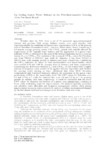Use este identificador para citar ou linkar para este item:
http://www.alice.cnptia.embrapa.br/alice/handle/doc/937457| Título: | Up scaling guava water balance in the Petrolina/Juazeiro growing area, Northeast Brazil. |
| Autoria: | TEIXEIRA, A. H. de C.  HERNANDEZ, F. B. T.   |
| Afiliação: | ANTONIO HERIBERTO DE C TEIXEIRA, CPATSA. |
| Ano de publicação: | 2012 |
| Referência: | Acta Horticulturae, Leuven, n. 959, p. 193-200, sept. 2012. |
| Conteúdo: | Weather data for 2011, from a net of 15 automatic agro-meteorological stations and previous field energy balance results, were used together with regression models for modelling the guava water requirement (GWR) in the growing area of Petrolina (Pernambuco state) - Juazeiro (Bahia state), Brazil, considering a 6.5-months average growing season (GS). GWRGS joined with rainfall, allowed the acquirement of the regional water balance and the application of a guava water indicator (GWIGS) calculated as the ratio of the total precipitation during a growing season (PGS) to GWRGS. The variation of the averaged GWRGS values for Petrolina, was from 750±6.9 to 950±10.5 mm, while for Juazeiro, it was from 730±6.2 to 900±9.2 mm, with pruning periods in January and June, respectively. Considering the GWIGS indicator, its values for both municipalities were found similar, which were around 0.38 and 0.08 for pruning done in January and June, respectively. Quantifying the differences between PGS and GWRGS, it was evident that a higher amount of irrigation water needed to be applied between September and October for growing cycles starting in June. Additional data from IBGE (Brazilian Geographical and Statistical Institute) allowed the inspection of the guava water productivity (GWP) at the municipality level. The GWP values for Petrolina were 4.1 and 3.3 kg m-3, while for Juazeiro they were 1.8 and 1.5 kg m-3, for pruning periods in January and June, respectively. It could be concluded that the lower GWP values for Juazeiro was because of a poorer crop management, resulting in lower yield, evidencing scope for improvements. The analyses spatially presented, can subsidize water allocation and irrigation management criteria, when aiming improvements on guava water productivity and yet, avoiding environmental damage by the fast climate and land use changes in the Brazilian semi-arid areas. |
| Thesagro: | Goiaba Água Balanço Hídrico Produtividade Recurso Hídrico |
| Palavras-chave: | Modelagem Guava |
| Notas: | Edição do Proceedings of the III International Symposium on Guava and other Myrtaceae, Petrolina, sept. 2012. |
| Tipo do material: | Artigo de periódico |
| Acesso: | openAccess |
| Aparece nas coleções: | Artigo em periódico indexado (CPATSA)  |
Arquivos associados a este item:
| Arquivo | Descrição | Tamanho | Formato | |
|---|---|---|---|---|
| Heriberto12012.pdf | 873,52 kB | Adobe PDF |  Visualizar/Abrir |









